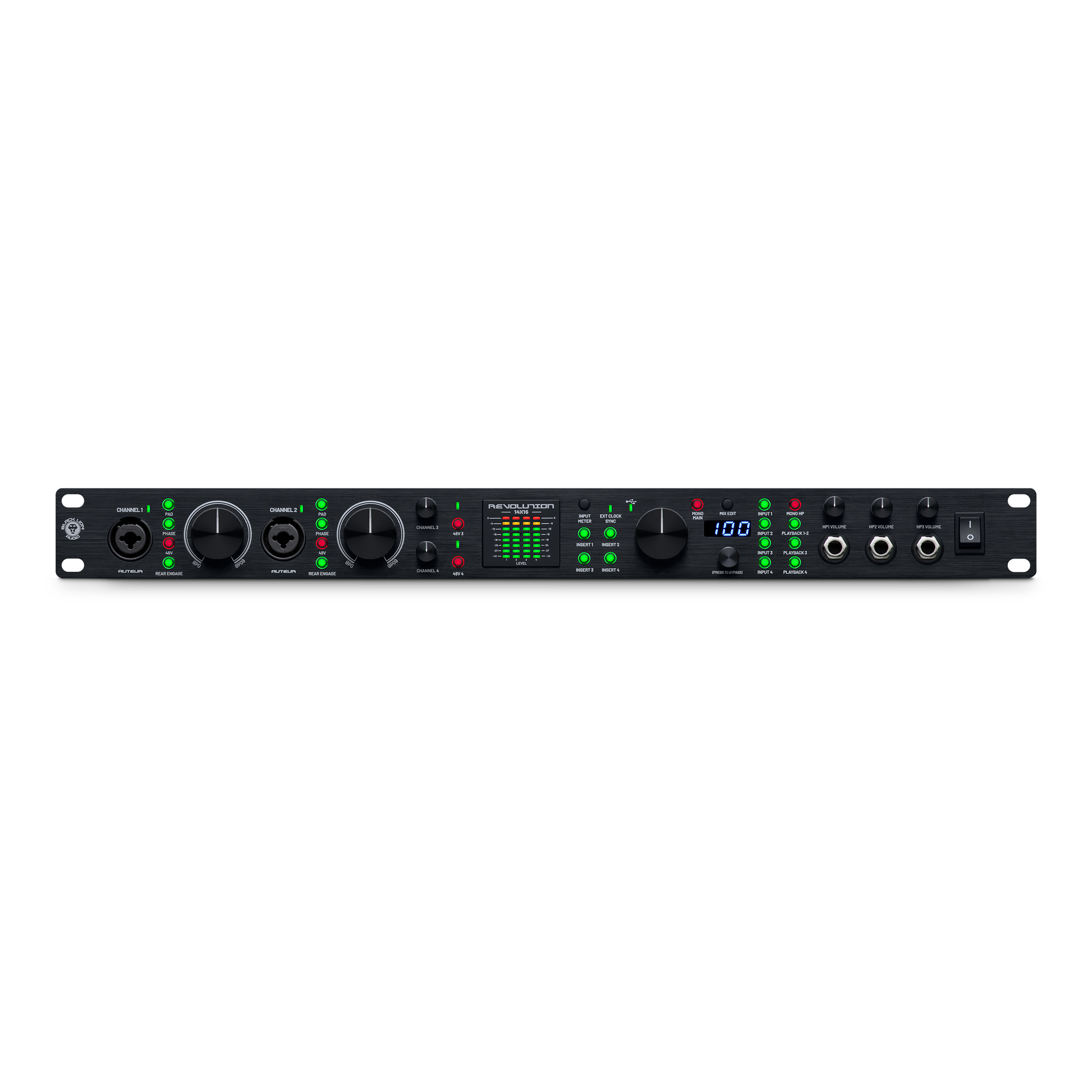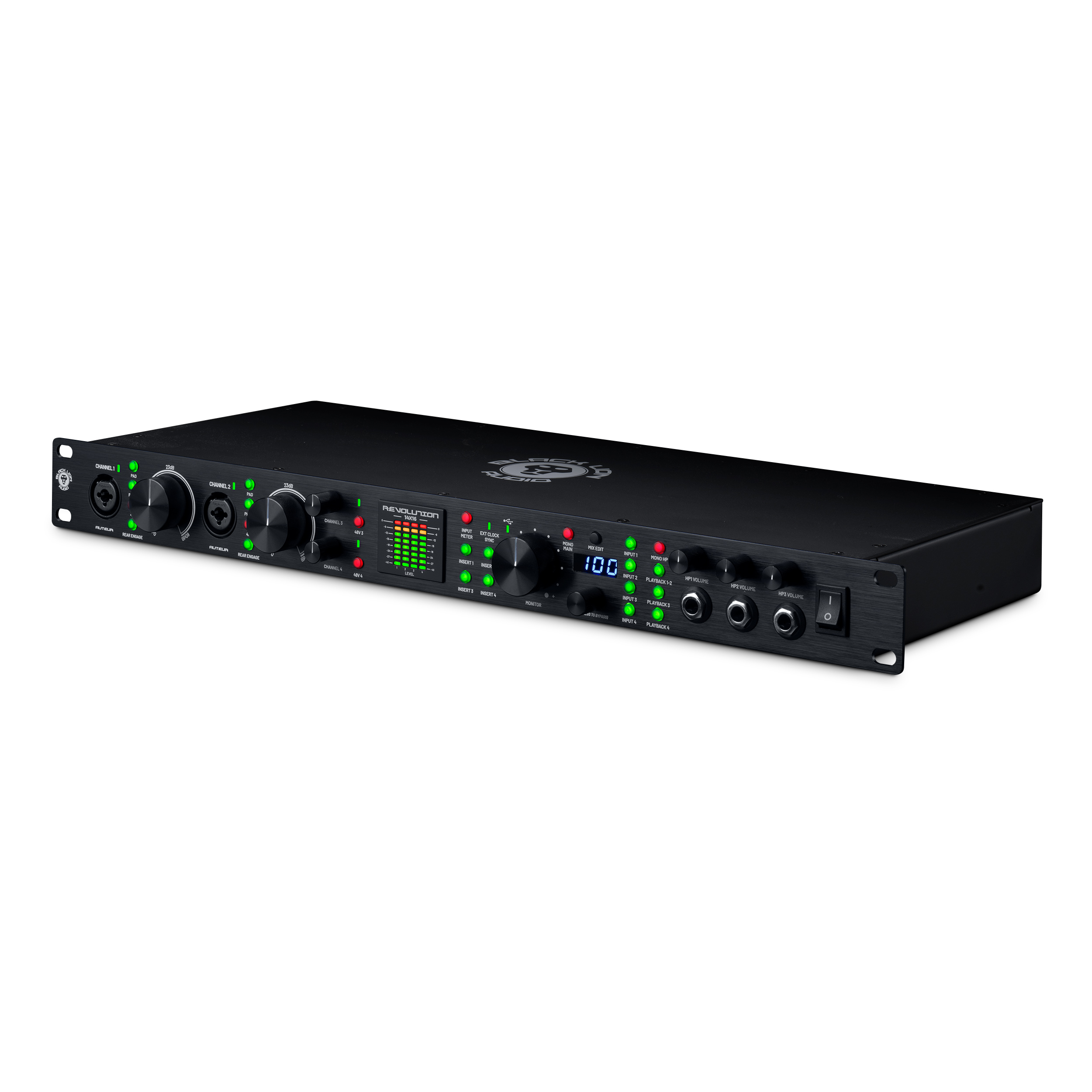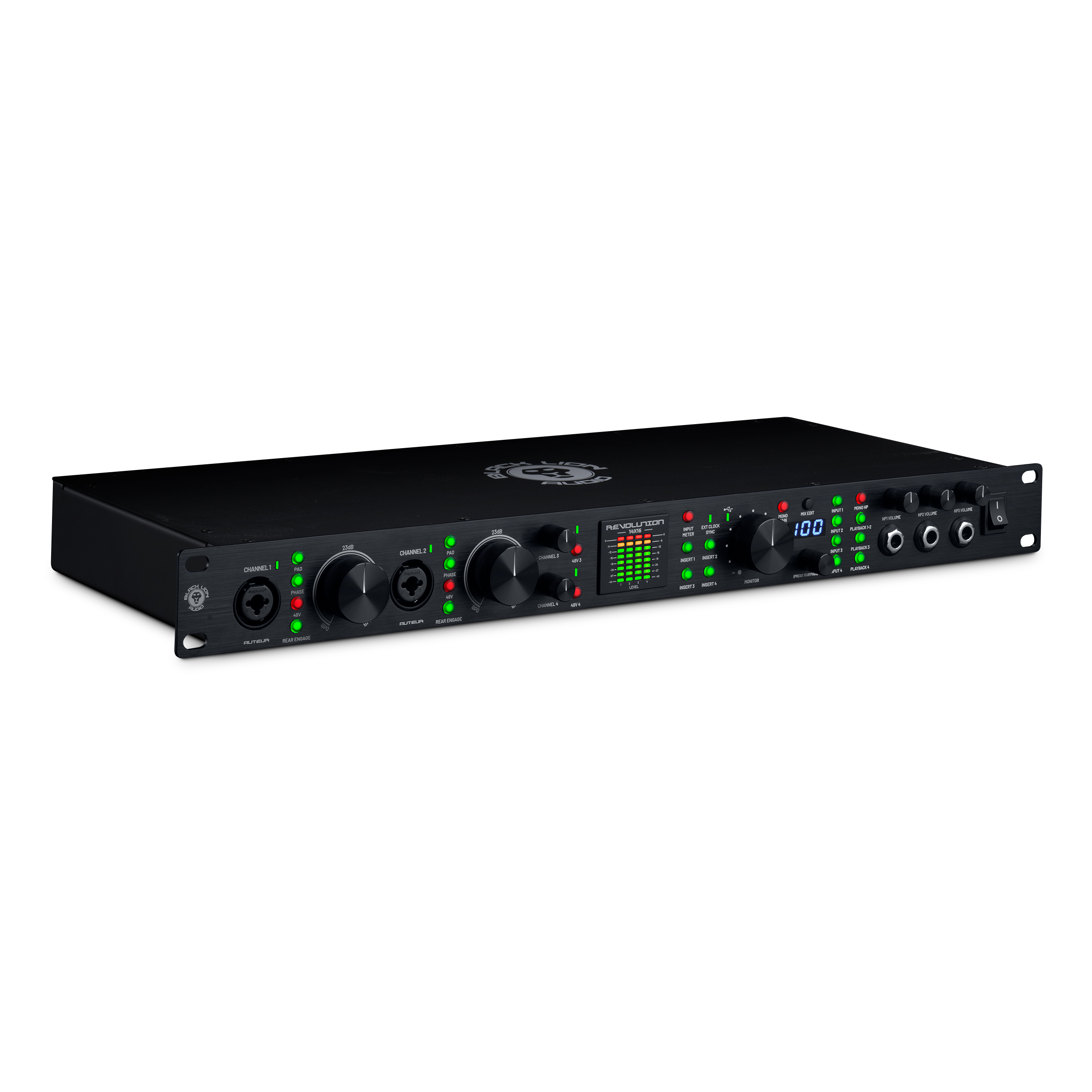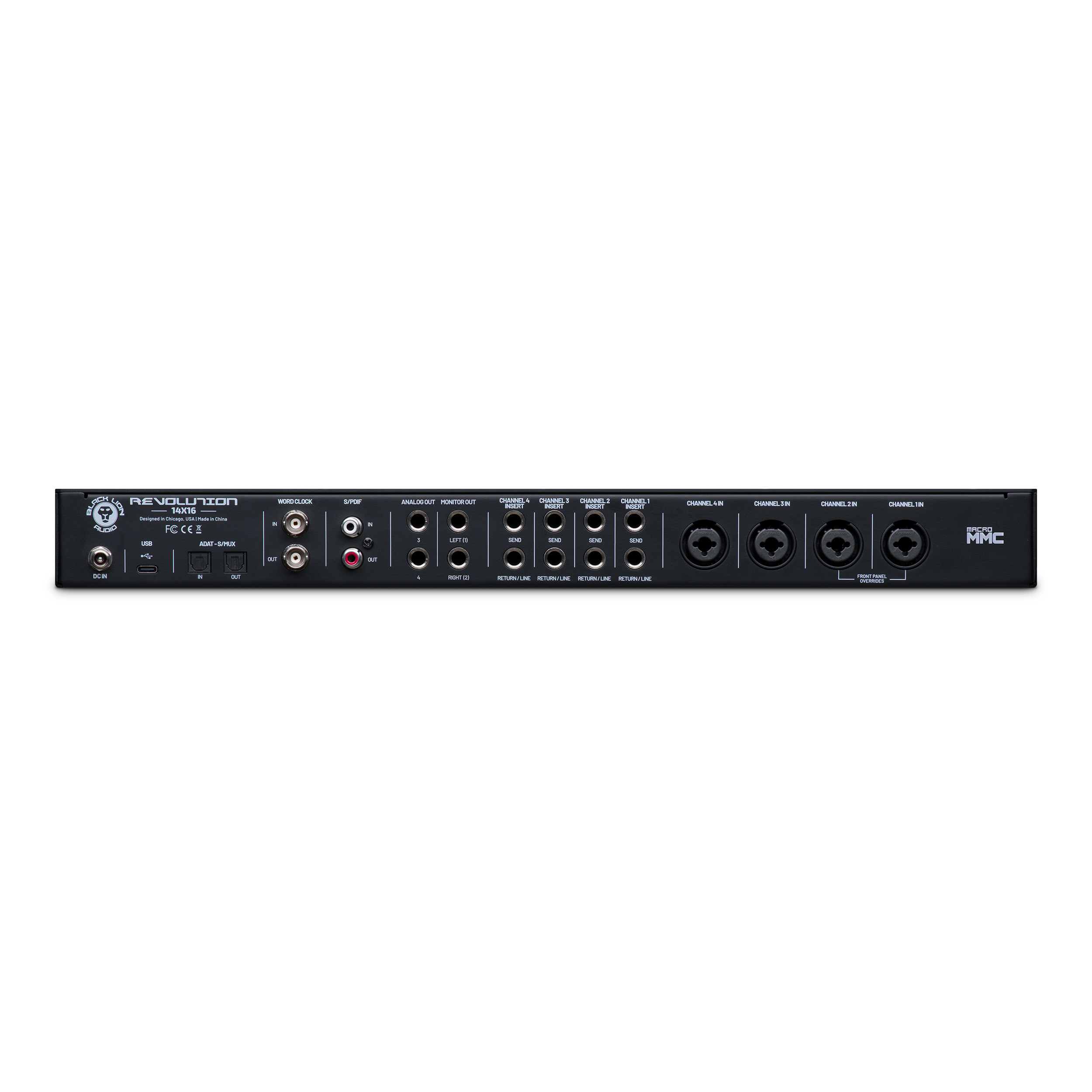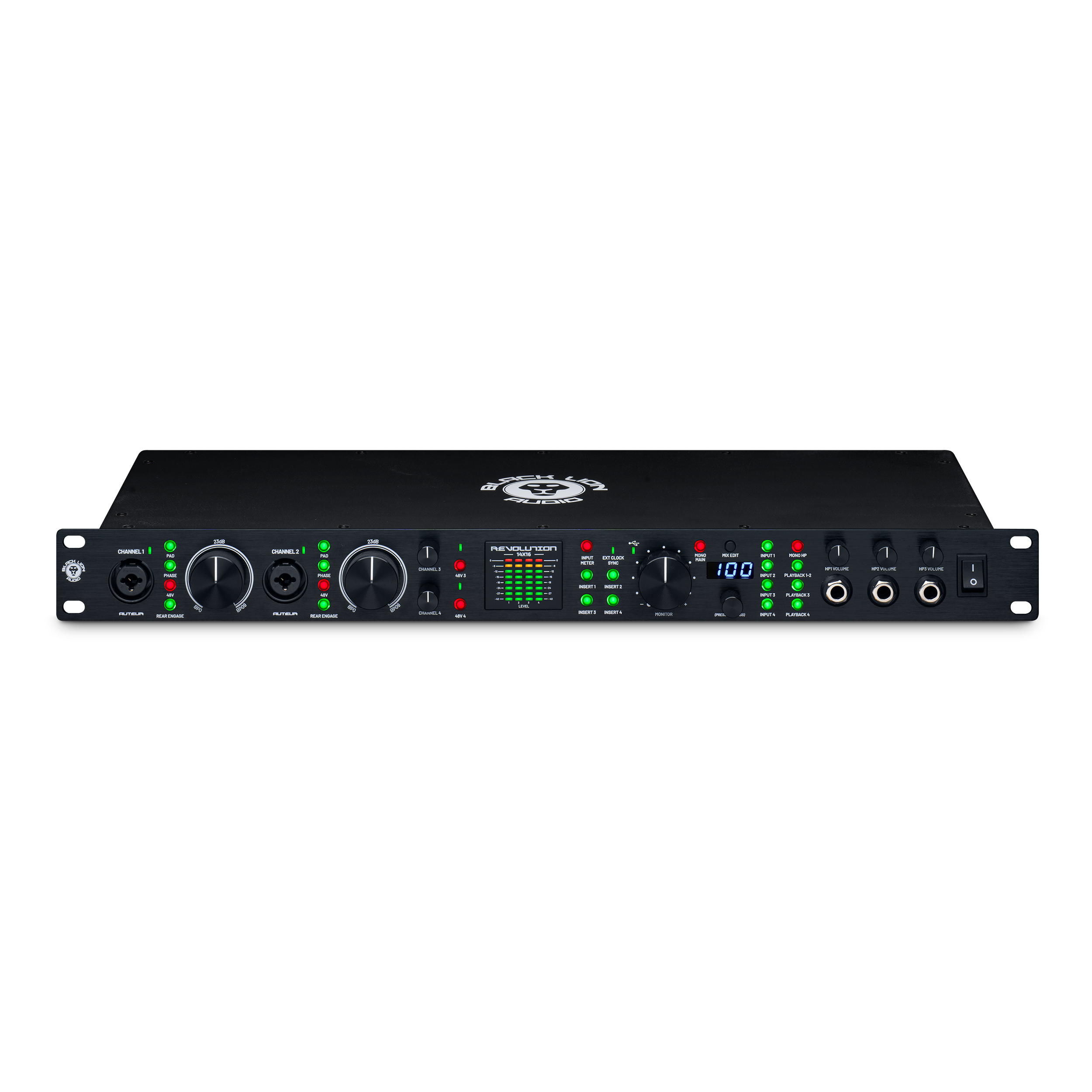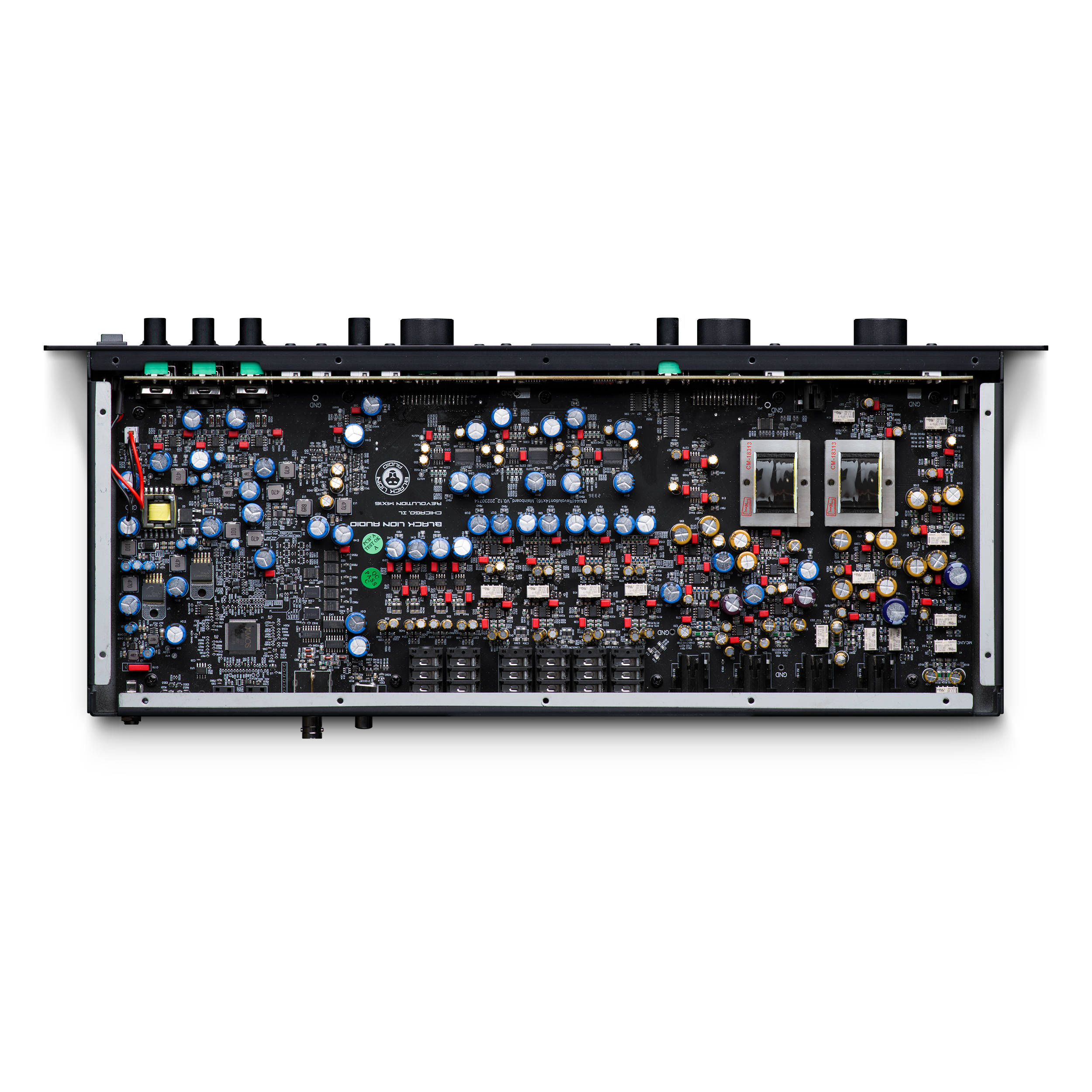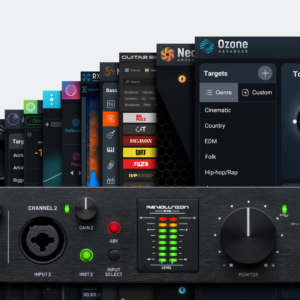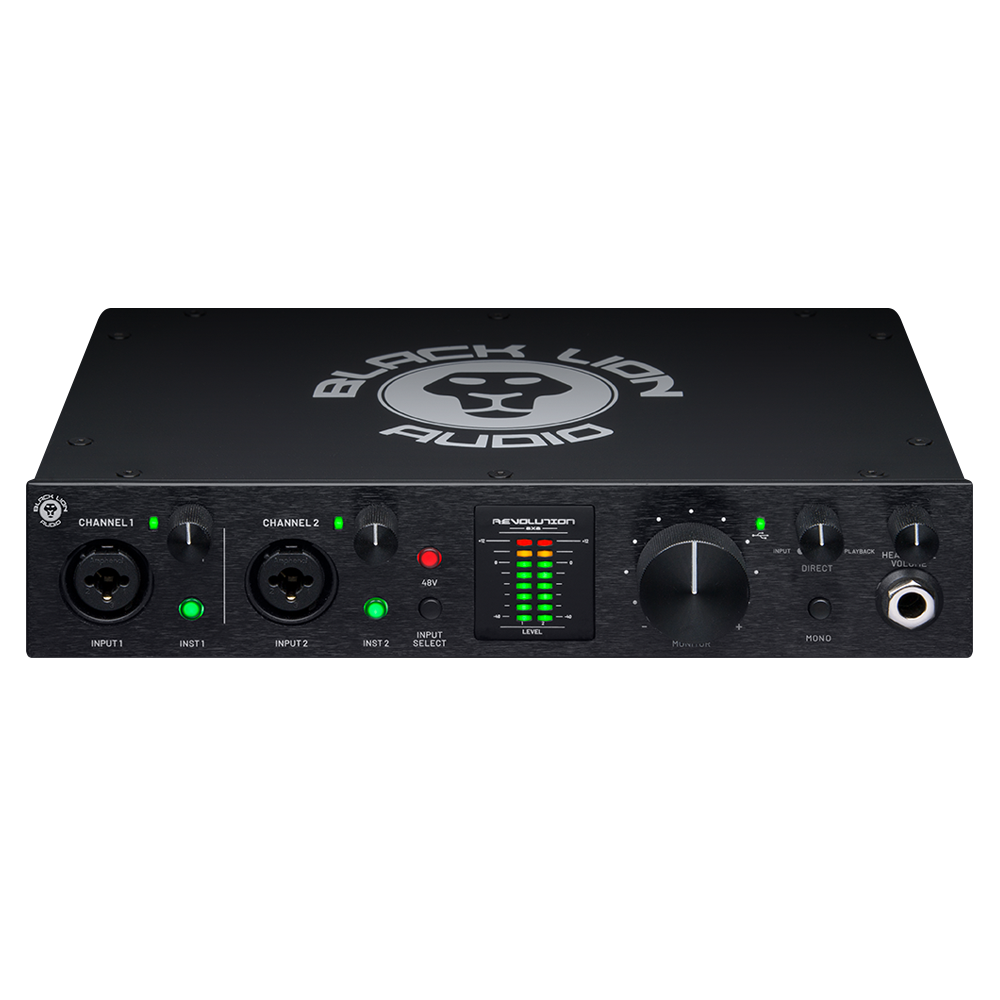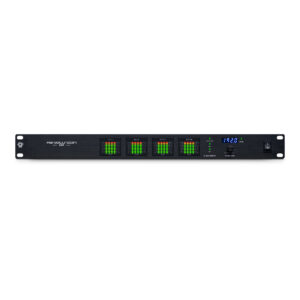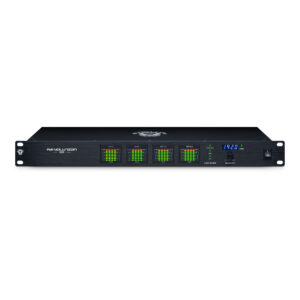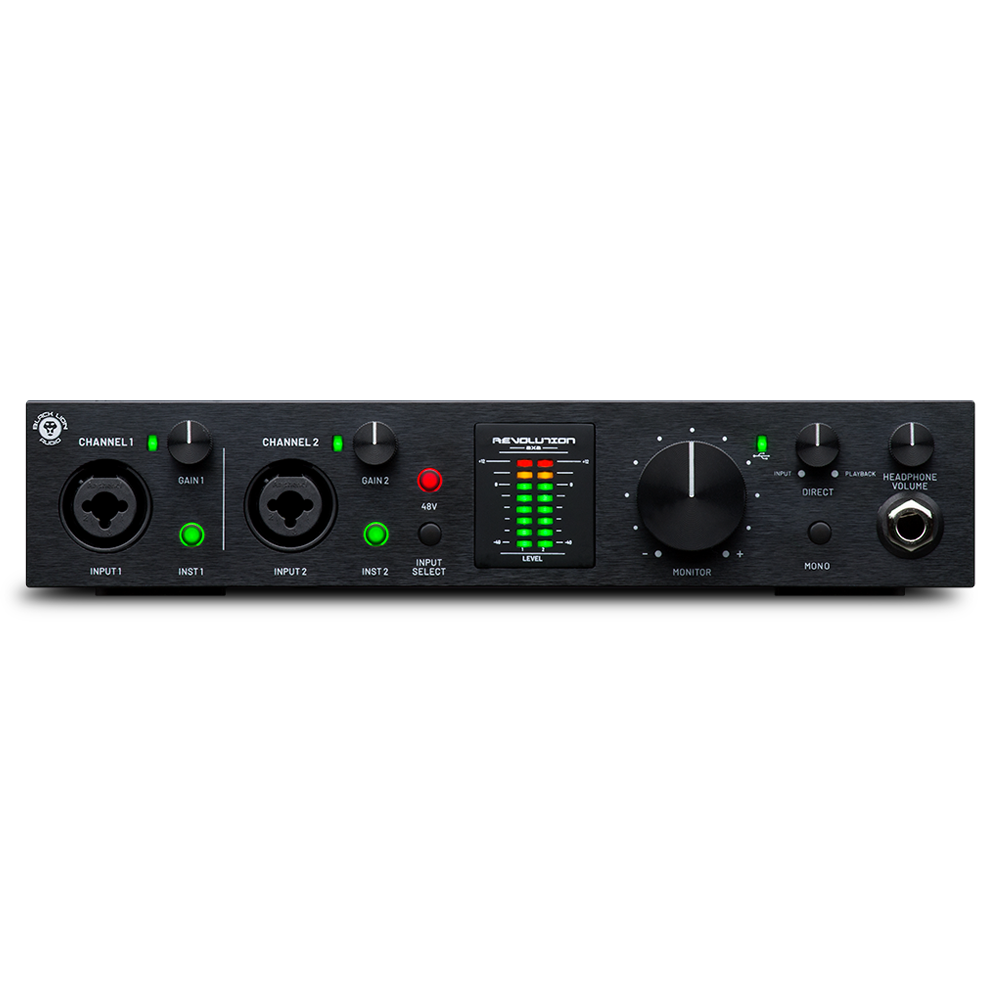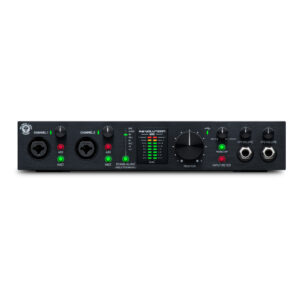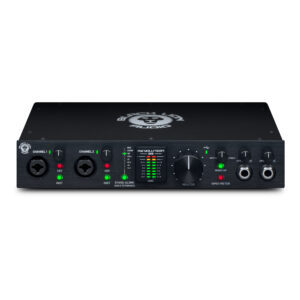Revolution 14×16
$1,299.00
The Revolution 14×16 is a class-compliant, 14-in / 16-out USB-C audio interface. Its built-in Cinemag transformer-driven Auteur preamps let you add weight and color to your tracks, and the headphone mixer lets you tailor a headphone mix from both hardware inputs and software playback. When your needs grow, Revolution 14×16 grows with you — add eight channels of input and output over ADAT; add external hardware processors via 4 switchable send/returns; and sync your hardware devices via our patented Macro-MMC clock; treating your music to world-class clocking and low-noise conversion.
Master control for your studio
The Revolution 14×16 is a class-compliant, 14-in / 16-out USB-C audio interface that delivers sterling Black Lion Audio audio quality, supreme clocking, and a robust suite of monitoring features unheard of in a 1U audio interface. It’s expandable via ADAT for additional I/O; boasts superior connectivity for your external processors; and even includes two channels of Black Lion Audio-designed Auteur preamps. The unique Mix Edit feature lets you create a custom headphone mix for its three crystal-clear headphone amps. Patented Macro-MMC clocking ensures that any hardware you sync to your Revolution 14×16 will sound its absolute best.
Auteur preamps built-in
Channels 1 and 2 of the Revolution 14×16 proudly feature Black Lion Audio’s Auteur preamps, which until now have only been available in our standalone preamp hardware. Auteur preamps deliver the best of both worlds of classic preamp designs — at lower gain levels, you get the fast attack of American-style preamps; a fantastic compliment for drums and rhythm guitar. Crank up the gain a bit, and you’ll get the warmth and color of classic British preamps, which can be particularly flattering to vocals and bass. You can access the Auteur preamps by connecting to either the front or rear Channel 1/2 inputs.
Auteur preamps are transformer-coupled like classic consoles of yore; Cinemag transformers are responsible for the added harmonic weight and saturation when pushed.
Unrivaled connectivity and expandability
The Revolution 14×16 plays well with others. You get four mic/instrument preamps; channels 1 and 2 can be accessed from either the front or back of the unit. You also get 4 switchable insert/returns for connection to external hardware processors; you can A/B your signal at the touch of a button. The Return connections double as Line inputs for keyboards, synths, and other line-level devices. You can even use the Revolution 14×16 as a standalone mic preamp with no computer connection, thanks to the Insert/Return connections.
A secondary set of user-definable Analog Outs let you route two analog signals wherever you like. S/PDIF connections round out the package for connection to digital devices, and the Revolution 14×16 is readily expandable with an additional 8-in and 8-out over ADAT. (We recommend the Revolution EXP for this.)
Versatile monitoring and metering
Revolution 14×16’s three crystal-clear, plenty-loud headphone amps let you and your collaborators produce music without worrying about feedback from your mains. Use the intuitive Mix Edit feature to quickly create a dedicated low-latency headphone mix from both hardware inputs and software playback.
Revolution 14×16’s bright, eight-stage metering can be set to monitor Channel input levels, output levels, or even the input levels of the rear-mounted Channel Inserts. The main Monitor and Headphone Outputs are mono-summable.
Shocking clocking
Rest assured that your connected devices will run in perfect sync with the Revolution 14×16 thanks to patented Macro-MMC clocking. Macro-MMC was developed from our experience creating dedicated word clocks, as well as modifying many embedded clocks found in other recording interfaces. You’ll get the best possible performance from its converters, and anything you connect via the BNC connections will benefit from maximum sync and ultra-low jitter; minimizing the phase distortions that can muddy your high-end and dull your transients.
If you’ve already invested in a clock you like, that’s fine — the Revolution 14×16 graciously accepts clock in.
Spared no expense
We’ve put everything we’ve learned about interfaces from years of boutique modding into the Revolution 14×16 — as we like to say, it’s modded out of the box — for crystal-clear audio that will move you and your fans. Highly-filtered power rails work with full-circuit power decoupling to further reduce noise contamination. And for the best possible capture and playback, Revolution 14×16 sports over two dozen high-end, hard-to-get Vishay, Wima, and Nichicon capacitors and thin film resistors. (A component-sourcing nightmare but an audiophile’s dream!) All internal gain-staging is optimized for the best signal-to-noise ratio. Last but not least, all analog I/O is fully decoupled and balanced — right to the very core of the converter — for even further noise reduction.
All the software tools you need, included.
The Revolution Software Suite covers all of your software needs so you can start creating from day one. You’ll record straight into the award-winning Studio One Pro, of course… and we’ve also included a ton of other valuable software:
PreSonus Studio One Pro+ (90 days): Recording and music production DAW, plus all the extras
Sonarworks SoundID Reference for Headphones: (90 days) Headphone calibration software
Audified GK Amplification 3 LE: Bass amp modeler of legendary Gallien-Krueger amps and cabs
Audified MixChecker: Mix checking plug-in with playback device emulations
Psychic Modulation EchoMelt3: BPM-based modulation and echo
Technical Specs
Mic Input
Auteur preamps (Channels 1 & 2)
Input Impedance = 6.1 kΩ
maximum input level @ gain min = +6.487 dBu
maximum input level @ gain max = -53.513 dBu
Frequency Response: frequency response 20hz to 20kHz @gain min (input level -1 dBFS) = +/-0.052dB
Frequency Response: frequency response 20hz to 20kHz @gain max (input level -1 dBFS) = +/-0.143dB
THD + N @ 1 kHz @ gain min (bandwidth 20hz-20kHz, un-weighted, (input level -1 dBFS) = 0023653%
SNR @ 1 kHz @ gain min (bandwidth 20hz-20kHz, A-weighted, (input level 0 dBFS ) = 111.263dB
Dynamic Range @ gain min (bandwidth 20hz-20kHz, A-weighted -level 0 dBFS) = 106.998 dB
Crosstalk = -90.991 dB
Revolution preamps (Channels 3 & 4)
Input Impedance = 2.08 kΩ
maximum input level @ gain min = +8.116 dBu
maximum input level @ gain max = -46.54 dBu
Frequency Response: frequency response 20hz to 20kHz @gain min (input level -1 dBFS) = +/-0.021 dB
Frequency Response: frequency response 20hz to 20kHz @gain max (input level -1 dBFS) = +/-0.022 dB
THD + N @ 1 kHz @ gain min (bandwidth 20hz-20kHz, un-weighted, (input level -1 dBFS) = 0.0010273%
SNR @ 1 kHz @ gain min (bandwidth 20hz-20kHz, A-weighted, (input level 0 dBFS ) = 107.975 dB
Dynamic Range @ gain min (bandwidth 20hz-20kHz, A-weighted -level 0 dBFS) = 111.010 dB
Crosstalk = -90.991 dB
Line Input
Input Impedance = 20 kΩ
Maximum Input (maximum input level @ gain min) = +16.2 dBu
Frequency Response = +/-0.025 dB
THD + N = 0.00187%
Dynamic Range = 111.412 dB
Crosstalk = -117.026 dB
Line Outputs
Main Outputs
Output Impedance = 47 Ω
Max Output Level = +16 dBu
Frequency Response = +/-0.095 dBu
THD+N = 0.00081%
Dynamic Range = 109.225 dB
Outputs 3 & 4
Output Impedance = 200 Ω
Max Output Level = +16 dBu
Frequency Response = +/-0.095 dBu
= HD+N = 0.00081%
Dynamic Range = 109.225 dB
Instrument Input
Input Impedance = 1 MΩ
Gain Range = 59.2415
Frequency Response = +/-0.051 dB
THD + N = 0.00491%
Dynamic Range = 106.135 dB
Crosstalk = -98.017 dB
Headphone Outputs
Output Impedance = 20 Ω
Maximum Signal Output = 2.652 Vrms
Frequency Response = +/-0.116 dB
**Dynamic range is affected by our preference to tuning individual stages for tonality. We found that the best sounding parts in the output path weren’t necessarily the lowest noise components but they resulted in an optimal tone and signal purity that is instantly apparent to the listener. Electronic design is a game of compromise and we’re confident your ears will agree with our choices.
iPhone models prior to iPhone 15 will require a lightning-to-USB OTG adapter.

